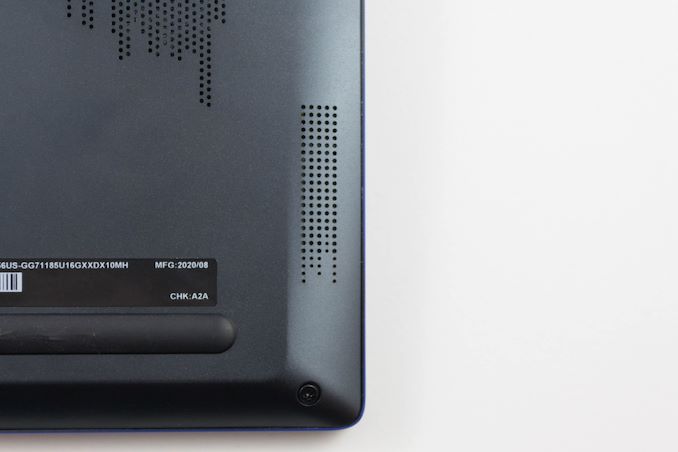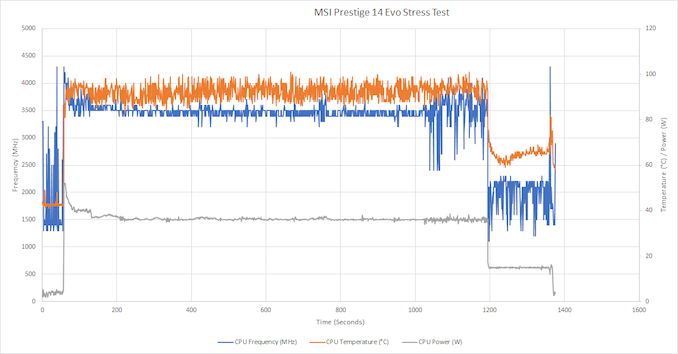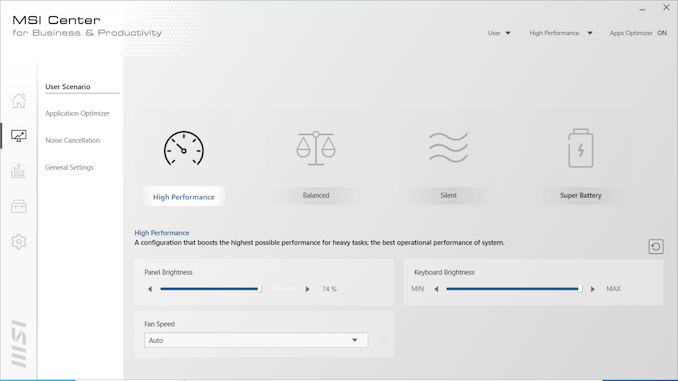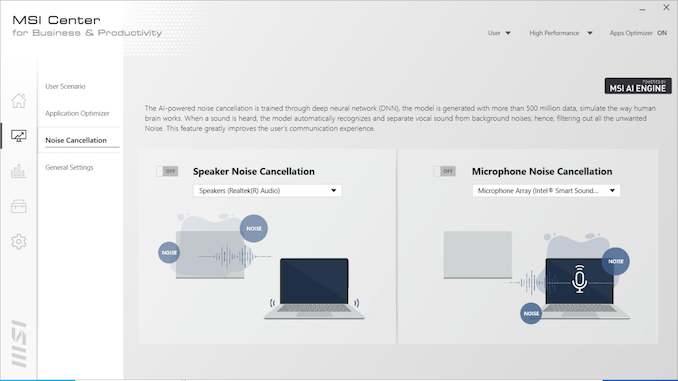The MSI Prestige 14 Evo Review: Testing The Waters Of Tiger Lake
by Brett Howse on December 17, 2020 10:00 AM EST- Posted in
- Laptops
- Intel
- MSI
- Tiger Lake
- Notebook
Wireless
As an Intel Evo device, Intel requires that the manufacturer include Intel’s Wi-FI 6 adapter, and luckily for all, that is not a burden on any device at the moment. Intel has continued to deliver the best Wi-Fi solutions in the industry. The MSI Prestige 14 Evo features the Intel AX201 Wi-Fi 6 network adapter. As a Wi-Fi 6 solution, it supports 160 MHz channels and 1024 QAM.

Performance is fantastic, with a maximum transfer rate of almost 1500 Mbps, easily eclipsing Gigabit Ethernet at short-range transfers. Intel’s driver stack is also one of the most reliable in the industry. The laptop never struggled with connections or resuming from sleep.
Audio
In a fairly typical setup, the MSI Prestige 14 features stereo speakers that are downwards firing, located at the front of the laptop. As is also typical in a thin and light design, there is not a lot of room for the drivers themselves. The speakers do not get very loud, hitting about 72 dB(A) measured an inch over the trackpad, and due to the small size of the drivers, there is not very much low-end punch.
Thermals
The terms thin, light, and high-performance don’t always go together, but we’ve seen the lines blurred in the last several years with some very impressive designs. The biggest challenge of any thin and light design is being able to dissipate the heat produced under load, due to a lower thermal mass and less airflow from the smaller designs. Adding to that challenge is Intel really pushing the limits of power draw in a small form factor, with high burst-power draw and now higher and higher sustained power draw on the latest devices. Intel has traditionally offered its U-Series chips as a nominal 15-Watt design, but the latest 10 nm designs have dropped the U and with Tiger Lake, have dropped the nominal TDP value altogether. Intel now specifies its Tiger Lake processors with a TDP range – in this case 12 to 28 Watts.
MSI offers a couple of difference performance modes which change the TDP of the processor significantly. The High Performance mode pretty much gives the CPU free reign, while the silent mode caps the system to a more typical 15-Watt TDP for the processor. To see how the device handled prolonged stress, it was run at 100% CPU load while monitoring temperatures and power draw.
In the High Performance mode, MSI has basically uncapped the CPU power draw. The CPU runs at an all-core turbo of 4.3 GHz initially with a peak power draw of almost 52 Watts, and then settles down to a sustained 30-Watt draw for the duration with the CPU frequency around 3.5 GHz. Rather than use power draw as a cap though, the processor is bouncing off the 100°C temperature limit, and throttling based on that. Near the end of the test, the laptop was switched to the Silent mode, which drops the power draw to just 15 Watts, which dramatically drops the CPU temperature, of course at the expense of frequency. MSI is very aggressive here. It is not very often we see a processor using the temperature limit as an upper limit on performance for such a sustained duration. Generally the device will cap power draw to a level that the device can more easily handle.
The good news is that this does remove the performance restriction for the end user, and the owner can choose the performance level based on individual needs and requirements. The bad news is that this does cause some significant noise from the system fans, which peaked at 52.4 dB(A) measured one inch over the trackpad. Compare this to the silent mode where the system fan is on but barely audible at just 37 dB(A) measured in the same location. The system has a very wide range of usability, and can be completely silent, to extremely loud, depending on how you want to use it.
Software
Practically every laptop now comes with some sort of control center, which lets you access specific device settings, as well as support options, and the MSI Prestige comes with the MSI Center for Business & Productivity. It is not the most elegantly named software suite, nor is it the best designed, but it does offer some good functionality.
As tends to be the case, the built-in suite is the easiest way to update drivers, and MSI’s Live Update is a great way to keep system drivers up to the latest versions. It allows you to quickly scan and download updates for Thunderbolt, audio, wireless, and other included hardware. It does not appear to allow BIOS updates, although it does at least display the current BIOS version information.
There is also the Optimizer options which let you choose the system performance and fan profile, as well as choose whether the Windows key is enabled, and to switch the Fn key with the Windows key.
MSI also includes a noise cancellation option, which uses the microphone to sense the ambient noise and attempt to cancel out some of the system noise. While this would be amazing to cancel out some of the sound from the system fans, it is only used for communication, which is unfortunate.
MSI also includes a couple of trial-ware software, such as Norton AV, and some Cyberlink products for media editing such as ColorDirector, AudioDirector, Music Maker, PhotoDirector, and PowerDirector. Luckily, if they are not needed, they can be uninstalled directly from the start menu.
















63 Comments
View All Comments
Vitor - Thursday, December 17, 2020 - link
Im just glad the display has decent accuracy.Teckk - Thursday, December 17, 2020 - link
This is a really good enough laptop for a lot of people and surprisingly good graphics performance by Intel. Is 1 Watt display not a requirement for Evo?gizmo23 - Thursday, December 17, 2020 - link
This laptop with 16:10 ratio display = take my money. As it is, I think my XPS will have to last a bit longer.s.yu - Friday, December 18, 2020 - link
My 2019 XPS132N1's digitizer experience really sucks, but I looked around the market and nothing really serves as a solid upgrade. If the latest Surface Book weren't so expensive with soon to be outdated graphics that would be my first choice.oRAirwolf - Saturday, December 19, 2020 - link
Offering a laptop with a 16x9 display when it's almost 2021 is pretty well. Get with the times MSI. 16x9 is fine on a large display, but laptops greatly benefit from some extra vertical real estatemobutu - Thursday, December 17, 2020 - link
almost bought this, luckily that I saw at the last time that, at the begining of 2021, it doesn't have at least one USB 3.x.A port ... good thing it has a TOTALLY USELESS 2.0.A one.I would torture the guys at msi for this stupid decision. what a bunch of retards .
ozzuneoj86 - Thursday, December 17, 2020 - link
I am totally confused by this decision as well. What a complete waste of a computer. What are you supposed to do with external storage devices that connect with USB A? Carry around adapters, or just deal with USB 2.0 speeds? In 2021!?!?And as a general complaint with most "nice" laptops these days, what if you use a mouse that connects via USB??? No flash drives then?
Might as well be an Apple product.
And no, it isn't a typo. The MSI site shows this across the board for all configurations of this model "USB: 1x USB 2.0"
Yakinabe - Thursday, December 17, 2020 - link
The USB 2.0 port is for your mouse. That's why it's on the right side. For faster peripherals like storage devices, it has two Thunderbolt ports. If you insist on keeping your legacy storage devices then yeah, you'd need to get a USB-C cable for your device, or carry an adapter.CharonPDX - Thursday, December 17, 2020 - link
Or use one of my dozens of USB-A 3.0 64-256 GB thumb drives. Or my external Blu-ray drive that has a tethered cable.Modern EFI and OSes can handle running a keyboard or mouse just fine over USB 3.0/3.1/3.2/4. There is no reason to continue to offer a USB 2.0 USB port.
The_Assimilator - Thursday, December 17, 2020 - link
While I agree that the choice of USB 2.0 is bizarre, my guess is that it's due to SOC peripheral bandwidth limitations - those two TB4 ports consume a LOT of PCIe lanes, and IIRC Tiger Lake has a relatively low PCIe lane count due to thermal and power constraints.